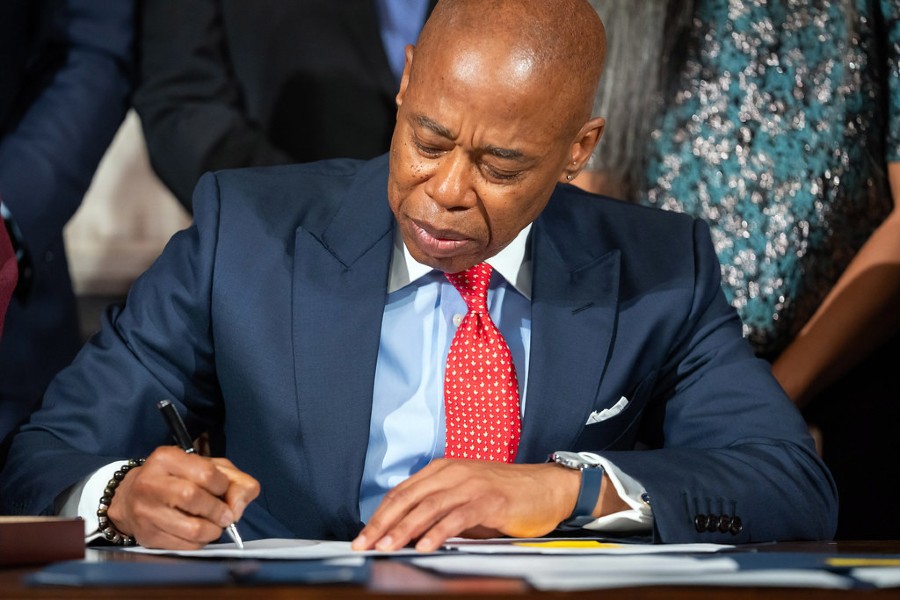
The Health Department today released the 2024 New York City Heat-Related Mortality Report, an annual report describing the toll that heat takes on the lives of New Yorkers.
The report shows that on average each year, there are about 350 heat-related deaths. Most of these are heat-exacerbated deaths, which happen when heat worsens existing health conditions such as heart disease. There are an average of seven heat stress deaths per year caused directly by heat. Heat-exacerbated deaths declined substantially between 1971 and 2000 and plateaued after 2000, but increased in the past decade as NYC’s climate has warmed. In recent years, deaths have plateaued.
“… the things we do to promote sustainability … can be lifesaving.”
“Climate change is making our summers hotter and more deadly,” said Health Commissioner Dr. Ashwin Vasan. “The risks to our planet present risks to our health, in part, because heat is the deadliest of all extreme weather events in the United States and in New York City. As a city we are stepping up our work to keep New Yorkers safe during these events. And the things we do to promote sustainability as a city, a country and as individuals can be lifesaving.”
“We mourn these unnecessary deaths and work daily to empower New Yorkers with awareness and resources to keep themselves and their loved ones safe,” said NYC Emergency Management Commissioner Zach Iscol. “Heat should not claim a single life. New Yorkers must prepare for heat with the same seriousness as we prepare for weather emergencies like hurricanes, flash floods, or snowstorms. Visit nyc.gov/beattheheat to see how the City can support your heat plan.”
“Extreme heat, which is becoming more frequent in Northern cities due to climate change, is an issue of public health, environmental justice, and economic inequality,” said Elijah M. Hutchinson, Executive Director of the Mayor’s Office of Climate & Environmental Justice. “With our bold initiatives to mitigate extreme heat – like planting trees in heat-vulnerable areas, developing a maximum indoor temperature, and working to reform the Home Energy Assistance Program – we envision a future without heat deaths and utility costs are not a barrier to cooling.”
“The report found that deaths were more likely to occur at home …”
The report found that deaths were more likely to occur at home, underscoring the importance of access to cooling at home. Heat stress deaths and heat-exacerbated deaths also continue to inequitably affect Black New Yorkers, reflecting the impacts of structural racism, which creates economic, educational, health care, housing, and other systems that systematically disadvantage Black New Yorkers.
About a third, or approximately 100, heat-exacerbated deaths are attributable to the most extreme heat days (i.e., days that meet the National Weather Service extreme heat advisory threshold for NYC). The rest occurred on non-extreme hot days, or days with temperature below the heat advisory threshold but above 82°F. These hot, but not extreme, days are also dangerous. The number of these hot days has increased over the past decade more quickly than extreme heat days. Over the same time period, home air conditioning rates remained steady after having increased over the previous decades, as shown in last year’s report. Without AC, indoor temperatures can be much higher than outdoors, especially at night, and can continue for days after a heat wave.
NYC continues to take steps to address the climate crisis and prepare residents for warming summers. The City’s long-term strategic climate plan, PlaNYC: Getting Sustainability Done, includes plans to extend home air conditioning by developing maximum temperature regulations by 2030, requiring cooling in new housing by 2025, and using state and federal subsidy programs, such as the Home Energy Assistance Program (HEAP). Eligible New Yorkers can obtain free air conditioners, including installation, through HEAP. More information on who is eligible and how to apply can be found online or by calling 311 and asking about the cooling assistance benefit.
“… visit the newly revamped Cool Options Map …”
New Yorkers can stay informed about the latest weather updates and other emergencies by signing up for Notify NYC, the city’s free emergency notification system, by calling 311, visiting the Notify NYC website, or downloading the Notify NYC app to sign up. All summer they can visit the newly revamped Cool Options Map to easily locate information on ‘cool options,’ including libraries, malls, and museums that offer air-conditioned spaces to escape the heat, as well as Cooling Center locations during heat emergencies. NYCEM has expanded partnerships to provide a wider range of cooling centers throughout the city, including pet-friendly options. NYCEM is also piloting a program to distribute ‘cool kits’ that contain essential heat safety items to delivery drivers, outdoor workers, and other at-risk groups.
Learn more about what the City is doing to protect New Yorkers from the effects of extreme heat and combat climate change. More data and information about heat, climate, and health is also available on the Health Department’s Climate and Health data hub.
Become a Harlem Insider!
By submitting this form, you are consenting to receive marketing emails from: . You can revoke your consent to receive emails at any time by using the SafeUnsubscribe® link, found at the bottom of every email. Emails are serviced by Constant Contact










